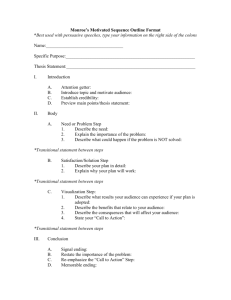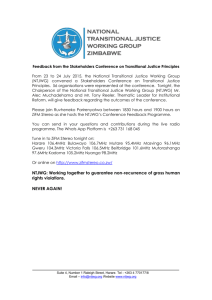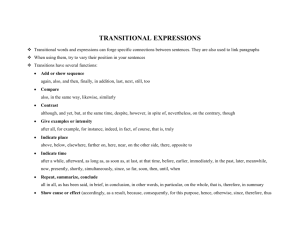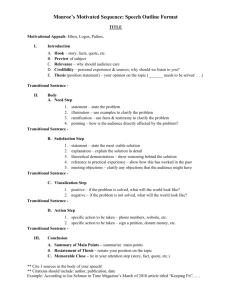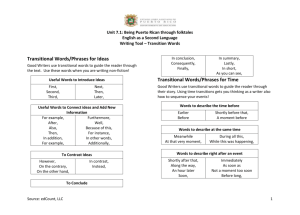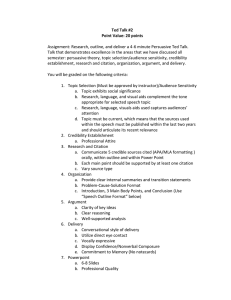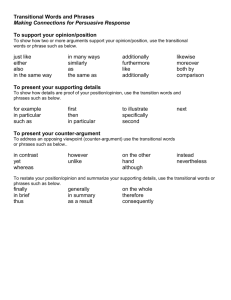Presentation
advertisement
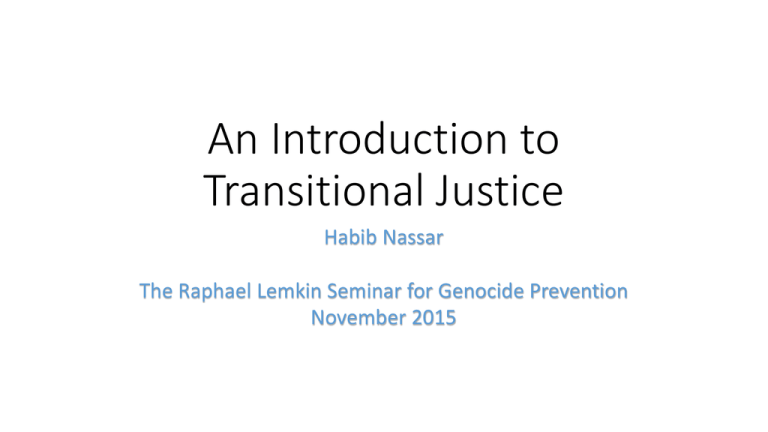
An Introduction to Transitional Justice Habib Nassar The Raphael Lemkin Seminar for Genocide Prevention November 2015 Summary of the Session What is TJ? A brief history of TJ and its evolution A look at the normative framework/foundation An overview of the main TJ approaches/processes Where does the field stand today? Challenges and Possibilities Between norms and reality: Possible group exercise Dissecting Transitional Justice Paradigms of transition What are the typical characteristics of a transition? Why justice? Justice for what? What legacy(ies) How to deliver justice in times of transition? Definitions of TJ “The notion of “transitional justice”… comprises the full range of processes and mechanisms associated with a society’s attempts to come to terms with a legacy of large-scale past abuses, in order to ensure accountability, serve justice and achieve reconciliation. These may include both judicial and non-judicial mechanisms, with differing levels of international involvement (or none at all) and individual prosecutions, reparations, truth-seeking, institutional reform, vetting and dismissals, or a combination thereof.” UN Secretary-General Report on The rule of law and transitional justice in conflict and post-conflict societies, August 2004 “This issue for [Transitional justice] … is to determine which elements of truth, justice, and clemency measures are compatible with one another, with the construction of democracy and peace, with emerging standards in international law, and with the search for reconciliation. The most appropriate mix will depend on context, circumstances, and the free and rational choices made by local actors (choices that the international community should feel bound to respect).” Juan Mendez, National Reconciliation, Transitional Justice and the ICC, Ethics and International Affairs, Spring 2001 The Latin American Moment Some features: • Negotiated transitions • Amnesties • Strong role of civil society and victims groups • Very limited role of external actors • The corrective role of the Inter-American Human Rights system The cornerstone of normatization: • The Velasquez Rodrigues v. Honduras Case Velasquez Rodriguez Case (1988) “States must prevent, investigate and punish any violation of the rights recognized by the [American] Convention and, moreover, if possible attempt to restore the right violated and provide compensation as warranted for damages resulting from the violation” (Paragraph 166) Normatization in Progress The Joinet Principles (1997) and the right to an effective remedy (Art. 2 ICCPR) : The right to know The right to justice The right to reparations Guarantees of non-recurrence Diane Orentlicher revisits the Joinet Principles (2005) reinforcing the prosecutorial component. International treaties: Geneva conventions, Genocide Convention, CAT Judicial Accountability Domestic/national trials International tribunals Hybrid tribunals Universal jurisdiction Judicial Accountability “Regulated vengeance” Individual responsibility v. collective guilt Establish a precedent Reinforce domestic judicial system Truth-seeking Commissions of Enquiry Fact-finding Bodies Truth commissions Civil society truth-seeking efforts Truth-seeking Reparations Restitution/Compensation/Rehabilitation/ Satisfaction/Guarantees of non-recurrence Individual/Collective Material/Symbolic The Post-ICC Moment The “impunity gap theory” and the centrality of criminal justice The boom of the TJ Industry The intense standardization The technical superseding the political Where we stand today and the post-Arabic Spring moment When Norms clash with reality: Yemen’s UN fiasco, Libya’s victor’s justice process, Egypt’s show trials, Tunisia’s hotchpotch TJ law Incapable of capturing complexities of the context and root causes of conflict or authoritarian system Marginalization of local ownership Undermining local creativity You have been asked to advise the UN Envoy on Syria on TJ 4-5 groups List four recommendations. 4 years conflict left 250K killed, half of the population displaced. War crimes and CaH have been documented by UN commission and NGOs. Multilayered conflict: Anti-oppression, sectarian, regional and international actors involved. Legacy of more than 40 years of dictatorship marked by pervasive use of torture, political imprisonment, enforced disappearance and mass killings. Legacy of sectarian divisions and economic marginalization of entire areas of the country. Legacy of corruption and cronyism sustaining repressive apparatus.

